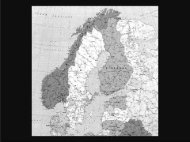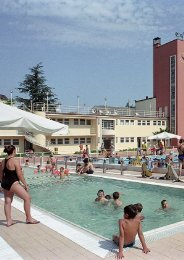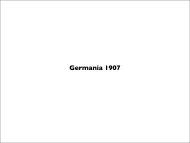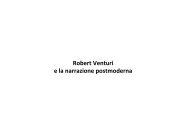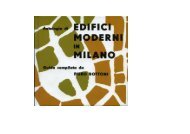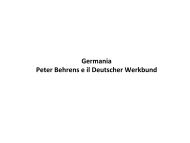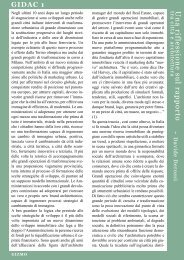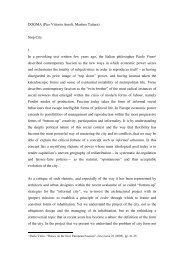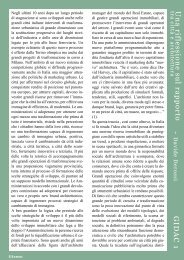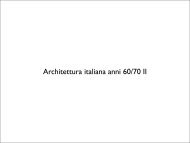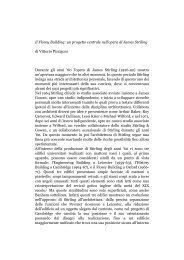laCappella Cimiteriale di ?1938?41 - GizmoWeb
laCappella Cimiteriale di ?1938?41 - GizmoWeb
laCappella Cimiteriale di ?1938?41 - GizmoWeb
You also want an ePaper? Increase the reach of your titles
YUMPU automatically turns print PDFs into web optimized ePapers that Google loves.
ERIK BRYGGMAN<br />
© MUSEUM OF FINNISH ARCHITECTURE, PHOTOGRAPHER SIMO RISTA<br />
<strong>laCappella</strong><br />
Silvia Micheli<br />
<strong>Cimiteriale</strong><br />
<strong>di</strong> (<strong>1938</strong>-<strong>41</strong>)<br />
THE CEMETERY CHAPEL IN TURKU<br />
Abitare la Terra 23/09 – P E R U N A A R C H I T E T T U R A D E L L A R E S P O N S A B I L I T À F O R A N A R C H I T E C T U R E O F R E S P O N S I B I L I T Y
1. Veduta interna<br />
della Cappella,<br />
aula e navatella<br />
Veduta interna<br />
della Cappella,<br />
aula e navatella<br />
2. Veduta esterna<br />
della Cappella,<br />
portico <strong>di</strong><br />
ingresso e<br />
campanile<br />
Veduta esterna<br />
della Cappella,<br />
portico <strong>di</strong><br />
ingresso e<br />
campanile<br />
3. Modello <strong>di</strong> stu<strong>di</strong>o<br />
della Cappella<br />
cimiteriale <strong>di</strong><br />
Turku<br />
Modello <strong>di</strong> stu<strong>di</strong>o<br />
della Cappella<br />
cimiteriale <strong>di</strong><br />
Turku<br />
2 3<br />
© MUSEUM OF FINNISH ARCHITECTURE, PHOTOGRAPHER SIMO RISTA<br />
35<br />
«Una parete <strong>di</strong><br />
vetro ininterrotta<br />
nella navata<br />
laterale che si<br />
affaccia sul lato<br />
sud permette ai<br />
pini che stanno<br />
fuori <strong>di</strong> prendere<br />
parte alla forma<br />
dello spazio<br />
interno e <strong>di</strong><br />
definire il suo<br />
tratto<br />
caratteristico [...]».<br />
Erik Bryggman<br />
«A solid glass wall<br />
in the side nave<br />
facing south<br />
allows the pine<br />
trees outside to be<br />
part of the shape<br />
of the space inside<br />
and helps to<br />
define its defining<br />
traits [...]».<br />
Erik Bryggman<br />
chitecture d’aujourd’hui, 2 Architectural<br />
Review 3 and Metron 4 .<br />
The Chapel was designed by the<br />
Finnish architect Erik William<br />
Bryggman (1891-1955), a wellknown<br />
professional from Turku<br />
and a key figure in modern Finnish<br />
architecture. When Bryggman<br />
started his career in the 1920s,<br />
Finland was experiencing a period<br />
of important economic change<br />
brought on by the political independence<br />
achieved in 1917. Industrial<br />
development flourished in<br />
the newly-established Finnish republic,<br />
in turn boosting the buil<strong>di</strong>ng<br />
sector. In keeping with the political<br />
and economic progress na-<br />
Nel 19<strong>41</strong>, quando<br />
nell’antica città finlandese<br />
<strong>di</strong> Turku<br />
viene ultimata la<br />
nuova Cappella cimiteriale,<br />
l’e<strong>di</strong>ficio<br />
è accolto dalla popolazione<br />
con un<br />
consenso così ampio,<br />
che alcuni anni dopo, sulle pagine<br />
del quoti<strong>di</strong>ano locale «Uusi<br />
Aura», si legge: «Come i citta<strong>di</strong>ni<br />
<strong>di</strong> Colonia conducono i loro ospiti<br />
innanzitutto alla Cattedrale, noi<br />
abitanti <strong>di</strong> Turku speriamo che<br />
nessuno rimanga senza aver visitato<br />
la nostra nuova e meravigliosa<br />
Cappella funeraria» 1 . Ben presto<br />
l’e<strong>di</strong>ficio conosce anche una fortuna<br />
internazionale, tanto da essere<br />
documentato sulle pagine delle più<br />
illustri riviste dell’epoca, tra le<br />
quali «L’Architecture d’Aujourd’hui»<br />
2 , «Architectural Review»<br />
3 e «Metron» 4 .<br />
L’autore della Cappella è l’architetto<br />
finlandese Erik William Bryggman<br />
(1891-1955), noto professionista<br />
<strong>di</strong> Turku ed esponente <strong>di</strong> rilievo<br />
dell’architettura moderna finlandese.<br />
Quando Bryggman si appresta a<br />
intraprendere la professione durante<br />
gli anni Venti del XX secolo, la<br />
Finlan<strong>di</strong>a è segnata da profon<strong>di</strong><br />
mutamenti economici dovuti al<br />
conseguimento dell’in<strong>di</strong>pendenza<br />
I<br />
n 19<strong>41</strong>, when the new<br />
cemetery chapel was<br />
completed in the old<br />
Finnish city of Turku,<br />
the inhabitants liked it<br />
so much that a few<br />
years later the following<br />
insert appeared in<br />
the local newspaper:<br />
“The inhabitants of Cologne take<br />
their guests to the Cathedral, in<br />
Turku we hope no-one leaves without<br />
visiting our new and wonderful<br />
funerary Chapel” 1 . The buil<strong>di</strong>ng<br />
quickly became so famous all over<br />
the world that it was published in<br />
some of the most important magazines<br />
of the period inclu<strong>di</strong>ng L’Ar-<br />
P E R U N A A R C H I T E T T U R A D E L L A R E S P O N S A B I L I T À F O R A N A R C H I T E C T U R E O F R E S P O N S I B I L I T Y – Abitare la Terra 23/09
36<br />
CAPPELLA<br />
tionwide, Bryggman committed<br />
himself to modernising the country’s<br />
architecture, taking into special<br />
consideration the Neues Bauen<br />
movement. In this he worked closely<br />
with his colleague Alvar Aalto<br />
who lived in Turku between 1927<br />
and 1933 5 . Together they actively<br />
contributed to the formal and constructive<br />
renewal of Finnish architecture:<br />
the Turku Fair, built in<br />
1929,was one of their first joint designs.<br />
Bryggman’s own personal<br />
contributions to the modernisation<br />
of his country’s architecture include<br />
the Finnish pavilion at the Antwerp<br />
Expo (1929-30), the Sports Club in<br />
Vierumäki (1930-36) and Villa<br />
Warén (1932-33). In these projects,<br />
Bryggman <strong>di</strong>dn’t wholeheartedly<br />
espouse the input of “new architecture”,<br />
but he <strong>di</strong>d assimilate its innovative<br />
ideas and adapted them to local<br />
requirements thanks to his talent,<br />
described by Reyner Banham<br />
in an article published in 1957 6 ,of<br />
“being very Finnish, yet at the same<br />
time not at all provincial, capable of<br />
gaining international estimate using<br />
a national style”. The cemetery<br />
chapel in Turku is based on this<br />
contrast between innovation and<br />
tra<strong>di</strong>tion which during the 1930s<br />
makes Finnish architecture one of<br />
4<br />
4. Vista esterna<br />
della Cappella<br />
Vista esterna<br />
della Cappella<br />
5. Facciata della<br />
Cappella, dettaglio<br />
della croce<br />
Facciata della<br />
Cappella, dettaglio<br />
della croce<br />
6. Vista esterna della<br />
navatella dal portico<br />
Vista esterna della<br />
navatella dal portico<br />
7. Planimetria<br />
generale del<br />
complesso funeario,<br />
soluzione definitiva<br />
Planimetria<br />
generale del<br />
complesso funeario,<br />
soluzione definitiva<br />
8. Sezione trasversale,<br />
soluzione definitiva<br />
Sezione trasversale,<br />
soluzione definitiva<br />
9. Sezione e prospetto<br />
laterale, I fase <strong>di</strong><br />
concorso (<strong>1938</strong>)<br />
Sezione e prospetto<br />
laterale, I fase <strong>di</strong><br />
concorso (<strong>1938</strong>)<br />
10. Veduta interna<br />
della Cappella,<br />
vetrata a fianco<br />
dell'altare<br />
Veduta interna della<br />
Cappella, vetrata a<br />
fianco dell'altare<br />
7<br />
6<br />
politica nel 1917. La neonata repubblica<br />
finlandese conosce un rapido<br />
sviluppo industriale e l’attività<br />
e<strong>di</strong>lizia riceve un forte impulso. In<br />
linea con il progresso politico ed<br />
economico nazionale, Bryggman si<br />
impegna nell’attuazione dell’aggiornamento<br />
architettonico del paese,<br />
con particolare attenzione all’esperienza<br />
del Neues Bauen. In questa<br />
prospettiva, Bryggman opera a stretto<br />
contatto con il collega Alvar Aalto,<br />
che tra il 1927 e il 1933 si stabilisce<br />
a Turku 5 . Insieme intraprendono<br />
un’azione decisiva per il rinnovamento<br />
costruttivo e formale<br />
dell’architettura finlandese, <strong>di</strong> cui<br />
la Fiera <strong>di</strong> Turku, progettata in collaborazione<br />
nel 1929, è tra i primi<br />
risultati. L’impegno che Bryggman<br />
de<strong>di</strong>ca al processo <strong>di</strong> aggiornamento<br />
dell’architettura nazionale emerge<br />
in modo autonomo già nel pa<strong>di</strong>-<br />
glione finlandese all’esposizione <strong>di</strong><br />
Anversa (1929-30), nell’Accademia<br />
dello Sport <strong>di</strong> Vierumäki (1930-<br />
36) e in villa Warén (1932-33). In<br />
questi progetti Bryggman non recepisce<br />
incon<strong>di</strong>zionatamente gli impulsi<br />
della “nuova architettura” ma<br />
ne assimila le spinte innovatrici declinandole<br />
in termini locali, grazie a<br />
quell’abilità «nell’essere regionale<br />
senza essere provinciale, <strong>di</strong> suscitare<br />
una stima internazionale usando<br />
un i<strong>di</strong>oma nazionale» come recita<br />
un articolo <strong>di</strong> Reyner Banham<br />
pubblicato nel 1957 6 . La Cappella<br />
cimiteriale <strong>di</strong> Turku è innervata da<br />
questa tensione tra innovazione e<br />
tra<strong>di</strong>zione che, durante gli anni<br />
Trenta del XX secolo, rende la produzione<br />
architettonica finlandese<br />
tra le più interessanti d’Europa e<br />
Bryggman tra i suoi migliori interpreti.<br />
Abitare la Terra 23/09 – P E R U N A A R C H I T E T T U R A D E L L A R E S P O N S A B I L I T À F O R A N A R C H I T E C T U R E O F R E S P O N S I B I L I T Y
CIMITERIALE DI TURKU<br />
37<br />
La vicenda della Cappella ha inizio<br />
nel <strong>1938</strong>, quando Bryggman riceve<br />
il primo premio al concorso in due<br />
fasi per un nuovo e<strong>di</strong>ficio funerario<br />
ban<strong>di</strong>to dalla Congregazione evangelica<br />
luterana <strong>di</strong> Turku. Il cantiere<br />
della Cappella viene aperto nel<br />
1939 e l’e<strong>di</strong>ficio risulta completato<br />
nel 19<strong>41</strong>. Bryggman prevede un<br />
grande volume regolare ad aula unica,<br />
intonacato e con copertura a pa<strong>di</strong>glione,<br />
preceduto da un portico<br />
d’ingresso e corredato dalla torre<br />
campanaria e da fabbricati <strong>di</strong> servizio.<br />
Internamente l’architetto progetta<br />
una spaziosa aula voltata in<br />
cemento, la cui curvatura irregolare<br />
sul lato sud permette ai pini che<br />
stanno fuori <strong>di</strong> prendere parte alla<br />
forma dello spazio interno e <strong>di</strong> definire<br />
il suo tratto caratteristico […].<br />
Gruppi <strong>di</strong> piante sono sistemati<br />
lungo la grande vetrata della navata<br />
laterale e nel santuario» 8 . Il significato<br />
sotteso a questa spiegazione<br />
si ra<strong>di</strong>ca nel concetto <strong>di</strong> luonto<br />
[la natura], un valore ancestrale<br />
nella storia del popolo finlandese.<br />
Nel XIX secolo, durante la stagione<br />
culturale nazional-romantica,<br />
l’idea della foresta come luogo della<br />
presenza <strong>di</strong>vina viene documentata<br />
nelle opere letterarie <strong>di</strong> celebri<br />
autori quali Aleksis Kivi, Zachathe<br />
most interesting in Europe and<br />
Bryggman one of its key interpreters.<br />
The story of the Chapel began in<br />
<strong>1938</strong> when Bryggman was awarded<br />
first prize in a competition for a new<br />
funeral buil<strong>di</strong>ng sponsored by the<br />
Evangelical Lutheran church of<br />
Turku. Work began in 1939 and the<br />
buil<strong>di</strong>ng was completed in 19<strong>41</strong>.<br />
Bryggman designed a huge regular<br />
volume with a single plastered hall<br />
preceded by an entrance portico. It<br />
had a pavilion roof, bell-tower and<br />
service buil<strong>di</strong>ngs. Inside the architect<br />
designed a spacious room with<br />
a concrete vaulted ceiling; its special<br />
curvature doesn’t appear to folfine<br />
its defining traits […]. Groups<br />
of plants are aligned along the big<br />
glass window of the side nave and<br />
in the sanctuary” 8 . The idea behind<br />
this explanation is based on<br />
the concept of luonto [nature], an<br />
ancestral value in the history of the<br />
Finnish population. In the nineteenth<br />
century, during the national-romantic<br />
cultural season, the<br />
idea that the forest was a place of<br />
<strong>di</strong>vine presence was documented<br />
in the literary texts of famous authors<br />
inclu<strong>di</strong>ng Aleksis Kivi,<br />
Zacharias Topelius and Ingeborg<br />
Hellén. Accor<strong>di</strong>ng to this interpretation,<br />
the navatella ensures spa-<br />
10<br />
8<br />
9<br />
© MUSEUM OF FINNISH ARCHITECTURE, PHOTOGRAPHER SIMO RISTA<br />
rias Topelius e Ingeborg Hellén.<br />
Secondo questa interpretazione, la<br />
navatella garantisce un rapporto <strong>di</strong><br />
continuità spaziale tra la foresta e la<br />
Cappella e permette <strong>di</strong> ottenere un<br />
unico tempio <strong>di</strong> Dio, un «santuario»<br />
appunto, dove si fondono l’arcaico<br />
mito pagano della natura e il<br />
credo religioso cristiano. Si chiarisce<br />
allora la <strong>di</strong>sposizione asimmetrica<br />
rispetto alla facciata principale<br />
del portico d’ingresso, la cui<br />
campata finale induce il fedele a<br />
contemplare la foresta, e anche<br />
l’orientamento delle panche nell’aula,<br />
ruotate rispetto all’asse estovest<br />
della Cappella, verso l’altare,<br />
il pulpito e la navatella. La <strong>di</strong>sposizione<br />
delle sedute, che detta un secondo<br />
asse dell’e<strong>di</strong>ficio, invita alla<br />
contemplazione del paesaggio attraverso<br />
la vetrata della navatella.<br />
La Cappella è impreziosita da nunon<br />
sembra seguire alcuno schema<br />
geometrico né corrispondere a una<br />
particolare tecnologia costruttiva,<br />
ma appare invece mutuata dalla tra<strong>di</strong>zione<br />
delle chiese finlandesi del<br />
XVII e XVIII secolo 7 .<br />
L’aula è affiancata dalla “navatella”,<br />
un corpo aggettante più basso,<br />
caratterizzato da una lunga vetrata<br />
che affaccia sulla foresta. La navatella,<br />
la più affascinante e al contempo<br />
la più enigmatica invenzione<br />
progettuale realizzata nella<br />
Cappella, è separata dall’aula da<br />
una fila <strong>di</strong> colonne astratte e si pone<br />
come un silenzioso vuoto tra<br />
l’interno e l’esterno dell’e<strong>di</strong>ficio.<br />
Quando Bryggman ne illustra il significato,<br />
sottolinea l’importanza<br />
del ruolo che la foresta assume nella<br />
definizione <strong>di</strong> questo volume:<br />
«Una parete <strong>di</strong> vetro ininterrotta<br />
nella navata laterale che si affaccia<br />
tial continuity between the forest<br />
and the Chapel and creates a single<br />
temple for God, a sanctuary in<br />
which the archaic pagan myth of<br />
nature and the religious credo of<br />
the Christians merge and unite.<br />
This explains the asymmetric position<br />
of the entrance portico vis-àvis<br />
the main façade: the final span<br />
of the portico invites the faithful to<br />
contemplate the forest. It also clarifies<br />
why the pews are not arranged<br />
along the east-west axis of the<br />
Chapel, but face the altar, the pulpit<br />
and the navatella.<br />
The Chapel is enhanced by certain<br />
design solutions which reflect<br />
Bryggman’s skill in interpreting<br />
the local architectural heritage.<br />
For example, in old me<strong>di</strong>eval<br />
Finnish churches, located mainly<br />
in the Turku region 9 , it was customary<br />
to impressed a cross or othlow<br />
any particular geometric pattern<br />
or buil<strong>di</strong>ng technique, instead<br />
it seems <strong>di</strong>rectly inspired by tra<strong>di</strong>tional<br />
seventeenth and eighteenthcentury<br />
Finnish churches 7 .<br />
Next to the hall is a navatella, a<br />
lower buil<strong>di</strong>ng jutting out to one<br />
side with a long glass window towards<br />
the forest. The navatella, the<br />
most fascinating and at the same<br />
time the most enigmatic design in<br />
the Chapel, is separated from the<br />
main hall by a row of abstract<br />
columns that create a silent void<br />
between the interior and exterior.<br />
When Bryggman explained its<br />
meaning, he emphasised the importance<br />
of the role that the forest<br />
plays in defining the volume: “A<br />
solid glass wall in the side nave<br />
facing south allows the pine trees<br />
outside to be part of the shape of<br />
the space inside and helps to de-<br />
P E R U N A A R C H I T E T T U R A D E L L A R E S P O N S A B I L I T À F O R A N A R C H I T E C T U R E O F R E S P O N S I B I L I T Y – Abitare la Terra 23/09
38<br />
l’ARCHITETTO<br />
<strong>di</strong> TURKU<br />
<strong>di</strong> Alvar Aalto<br />
traduzione in italiano dall’originale <strong>di</strong> / translation from the original into Italian by Silvia Micheli<br />
S<br />
ERIK BRYGGMAN, 1926<br />
Questo breve articolo firmato da Alvar<br />
Aalto è depositato sotto forma <strong>di</strong><br />
ritaglio <strong>di</strong> giornale presso il Museo <strong>di</strong><br />
Architettura Finlandese (MFA) a<br />
Helsinki, nell’archivio <strong>di</strong> Erik Bryggman.<br />
Aalto lo pubblicò su un quoti<strong>di</strong>ano<br />
locale probabilmente nel 1928.<br />
Il presente articolo, che viene qui<br />
ripubblicato per la prima volta,<br />
documenta la stima nutrita da Aalto nei<br />
confronti del collega Bryggman.<br />
olitamente non abbiamo intenzione<br />
<strong>di</strong> sviluppare l’architettura attraverso<br />
la critica sui quoti<strong>di</strong>ani. Molte sono<br />
le ragioni per le quali scrivere <strong>di</strong> architettura<br />
sui giornali non porta a buoni risultati,<br />
non è neppure possibile. La critica<br />
dell’architettura deve muovere da una<br />
grande profon<strong>di</strong>tà ed essere formulata<br />
con professionalità e positivismo, secondo<br />
principî nuovi. Ma ciò nonostante, anche<br />
i piccoli commenti marginali e le analisi<br />
intime hanno la loro fondatezza e buone<br />
possibilità <strong>di</strong> comunicare qualcosa.<br />
Le città <strong>di</strong> antica cultura hanno spesso<br />
una sorta <strong>di</strong> ambizione borghese, che<br />
forse si manifesta generalmente sotto forme<br />
patriottiche, ma che alla fine ha un interesse<br />
proprio per lo sviluppo armonico<br />
della città e per i valori estetici. Alcuni<br />
esempi isolati dell’architettura <strong>di</strong> Turku<br />
possono piacere ai patrioti della città.<br />
Ciò mi rimanda all’ultimo e<strong>di</strong>fico <strong>di</strong> Erik<br />
Bryggman, in corso <strong>di</strong> completamento.<br />
A molti è naturalmente nota la posizione<br />
importante che l’architetto “<strong>di</strong> Turku” occupa<br />
nell’architettura del nostro paese;<br />
egli è anche uno dei pochi architetti fin-<br />
landesi conosciuto e apprezzato dalla<br />
critica internazionale. In Finlan<strong>di</strong>a il suo<br />
ruolo nell’ambiente professionale è riconosciuta<br />
già dai tempi in cui egli era<br />
studente. Uno dei suoi primi lavori è il<br />
monumento ai caduti <strong>di</strong> Helsinki, che<br />
costituisce un modello per tutti quei numerosi<br />
artisti <strong>di</strong> minor talento e che ancora<br />
oggi resta il monumento ai caduti<br />
meglio progettato e più raffinato.<br />
La maggior parte delle opere <strong>di</strong> Bryggman<br />
si trova comunque a Turku. Si tratta<br />
prevalentemente <strong>di</strong> e<strong>di</strong>fici residenziali,<br />
dei quali salta all’occhio una caratteristica<br />
del tutto particolare: la capacità<br />
dell’architetto <strong>di</strong> restituire una forma ad<br />
un ambiente in apparenza assai poco<br />
interessante, migliorando l’immagine<br />
d’insieme senza esagerazioni. Quando<br />
si compie lo sforzo <strong>di</strong> analizzare con attenzione<br />
ogni suo e<strong>di</strong>ficio, alla fine si<br />
nota che ciò che a prima vista era forse<br />
indecifrabile, in realtà è basato su una<br />
sobrietà progettata coscientemente e attentamente.<br />
L’Atrium, e l’e<strong>di</strong>ficio in costruzione<br />
accanto ad esso 1 , sono esempi<br />
così eccellenti che non se ne trovano<br />
<strong>di</strong> eguali nelle nostre città. Ancora una<br />
volta dobbiamo essere grati a quest’uomo<br />
che, con questo gruppo <strong>di</strong> e<strong>di</strong>fici<br />
abilmente progettati, ha salvato la parte<br />
più desolata della via Yliopistonkatu.<br />
L’e<strong>di</strong>ficio dell’architetto Bryggman appena<br />
costruito all’angolo tra le vie Humalistonkatu<br />
e Eerikinkatu 2 , con l’hotel e<br />
i ristoranti, la cui facciata non è ancora<br />
terminata mentre gli interni sono già<br />
completati, probabilmente fa pensare<br />
molti. Per quanto mi riguarda, quando<br />
l’ho visto con il suo “pubblico”, mi ha richiamato<br />
alla mente quella curiosa idea<br />
<strong>di</strong> pluralismo che è parte integrante del<br />
significato della parola <strong>di</strong> uso corrente<br />
cultura. Indubbiamente nella parola cultura<br />
c’è una parte <strong>di</strong> imitatio, <strong>di</strong> appren<strong>di</strong>mento,<br />
<strong>di</strong> accettazione, che spesso<br />
non viene approfon<strong>di</strong>ta. Quando si afferma:<br />
«Un pezzo <strong>di</strong> Parigi al nord» nel<br />
momento in cui il problema riguarda lo<br />
sviluppo della messa a fuoco della nostra<br />
vita, allora i nostri occhi luccicano <strong>di</strong><br />
orgoglio per “quello che siamo”. E sicuramente<br />
in tutto ciò risiede la reale comprensione<br />
del lato primitivo del concetto<br />
<strong>di</strong> cultura. Alla stessa categoria <strong>di</strong> imitatio<br />
appartiene l’idea <strong>di</strong> “continentalità”,<br />
che per esempio caratterizza gli interni<br />
dei nostri ristoranti tipo “Pagoda” o “Alhambra”,<br />
così come i club inglesi copiati<br />
dai nostri ristoranti <strong>di</strong> prima classe, e<br />
l’uso del concetto <strong>di</strong> continentalità nella<br />
forma della vita <strong>di</strong> tutti noi 3 .<br />
Ma come ci si sente bene quando si<br />
può vedere talvolta una più chiara e coraggiosa<br />
comprensione della cultura,<br />
come avviene negli interni <strong>di</strong> questo ristorante,<br />
e sala da ballo, progettato<br />
dall’architetto Bryggman.<br />
Qui l’illuminazione è ben progettata, stu<strong>di</strong>ata<br />
matematicamente, e allo stesso<br />
tempo bella. Non v’è alcuna decorazione<br />
superficiale e priva <strong>di</strong> funzione. Le pareti<br />
sono pensate come sfon<strong>di</strong> per le persone<br />
e non come superfici senza utilità; e<br />
laddove c’è una decorazione architettonica<br />
in<strong>di</strong>pendente, essa è arrangiata alla<br />
perfezione, come un pizzico <strong>di</strong> sale<br />
necessario. Raramente è possibile trovare<br />
una combinazione tale tra festosità e<br />
sobrietà, abilmente unite da un filo rosso.<br />
Lo stesso tipo <strong>di</strong> pensiero anima fortemente<br />
molte altre opere <strong>di</strong> Erik Bryggman,<br />
il cui segreto risiede certamente<br />
nel lavoro e nella concentrazione portati<br />
ai massimi livelli.<br />
Sulle sponde del fiume Aura esistono tanti<br />
vecchi e<strong>di</strong>fici che appartengono alla<br />
meravigliosa tra<strong>di</strong>zione del nostro paese<br />
4 . Per fortuna nella vecchia Turku c’è un<br />
uomo che, con sensibilità, è in grado <strong>di</strong><br />
comprendere la <strong>di</strong>gnità <strong>di</strong> quell’ambiente<br />
e <strong>di</strong> creare il nuovo; e il risultato non è<br />
solamente lo sviluppo della ”architettura<br />
<strong>di</strong> Turku” bensì è anche un contributo prezioso<br />
all’illustre opera che, sia in ambito<br />
internazionale sia a livello nazionale, la<br />
rende progressivamente armoniosa e<br />
nuova, un compito che durante la stagione<br />
artistica della nostra civiltà è sembrato<br />
così spesso <strong>di</strong>fficile.<br />
––––––––––––––––––––––––––––––<br />
Si ringrazia Timo Keinänen per l’aiuto alla comprensione<br />
del testo.<br />
1 Aalto si riferisce all’hotel Hospitz Betel (Turku,<br />
1926 - 34).<br />
2 Aalto si riferisce all’hotel Seurahuone (Turku,<br />
1927 - 28).<br />
3 In queste frasi le parole <strong>di</strong> Aalto sono enigmatiche.<br />
Una possibile interpretazione è che l’architetto<br />
finlandese si riferisca al modo superficiale <strong>di</strong> utilizzare<br />
motivi e linguaggi architettonici internazionali<br />
importati in Finlan<strong>di</strong>a. «Un pezzo <strong>di</strong> Parigi al<br />
nord» significa à la parisienne, interpretabile come<br />
“la trattazione superficiale delle forme francesi”.<br />
Tale concetto viene riba<strong>di</strong>to a proposito<br />
dell’«idea <strong>di</strong> “continentalità” […] dei nostri ristoranti<br />
tipo “Pagoda” o “Alhambra” così come nei<br />
club inglesi». Il tono è a tratti ironico, quando «i nostri<br />
occhi luccicano <strong>di</strong> orgoglio per “quello che siamo”»<br />
e anche accusatorio verso il popolo finlandese<br />
che si compiace acriticamente <strong>di</strong> architetture<br />
frutto <strong>di</strong> una mera imitazione formale, senza una<br />
reale comprensione <strong>di</strong> cosa realmente implichi il<br />
concetto <strong>di</strong> “cultura”. Invece, in seguito, Aalto loda<br />
Bryggman per la sua profonda, e non primitiva,<br />
comprensione del concetto <strong>di</strong> “cultura” e per la<br />
sua capacità <strong>di</strong> saper restituire rispettosamente un<br />
nuovo volto architettonico alla città <strong>di</strong> Turku.<br />
4 Fiume che attraversa il centro della città <strong>di</strong> Turku.<br />
LA CAPPELLA È<br />
IMPREZIOSITA DA<br />
NUMEROSE SOLUZIONI<br />
PROGETTUALI, FRUTTO<br />
DELLA CAPACITÀ DI<br />
BRYGGMAN DI<br />
INTERPRETARE IL<br />
PATRIMONIO<br />
COSTRUTTIVO LOCALE.<br />
vrappone una seconda croce in ferro<br />
delle medesime <strong>di</strong>mensioni, collegata<br />
alla parete da sottili supporti<br />
metallici. Con la luce solare, la<br />
croce in ferro crea un’ombra che,<br />
proiettata sulla parete, ne <strong>di</strong>segna<br />
una terza in riferimento al concetto<br />
<strong>di</strong> Trinità. Inoltre Bryggman evoca<br />
l’antica tecnica costruttiva in blocchi<br />
<strong>di</strong> granito delle chiese me<strong>di</strong>oevali.<br />
Alla base del complesso funerario<br />
<strong>di</strong> Turku, il rivestimento esterno<br />
in lastre irregolari <strong>di</strong> granito rafforza<br />
il raccordo dell’e<strong>di</strong>ficio al terreno:<br />
le lastre sono più fitte in corrispondenza<br />
della base e si <strong>di</strong>radano<br />
nella parete fino a <strong>di</strong>ssolversi.<br />
Come ha notato Kenneth Frampton,<br />
nella Finlan<strong>di</strong>a degli anni<br />
Quaranta, proprio quando la Cappella<br />
<strong>di</strong> Turku è in fase <strong>di</strong> costruzione,<br />
pesava la «crescente convinzione<br />
che il vernacolo in generale,<br />
e quello finlandese in particolare,<br />
contenesse in sé una potenziale<br />
risposta alla crisi attuale» 10 .<br />
È opportuno precisare che la “crisi”<br />
a cui Frampton fa riferimento è<br />
dovuta allo scoppio della Talvisota<br />
er geometric symbols in the façade.<br />
In the funerary chapel, Bryggman<br />
doesn’t just propose this solution<br />
but, through a process of reinvention,<br />
puts an iron cross of the same<br />
size above the one engraved on the<br />
façade: he uses thin metal supports<br />
to fix it to the wall. In the sunlight,<br />
the iron cross casts a shadow which,<br />
falling on the wall, creates a third<br />
cross – a reference to the Trinity.<br />
Moreover, Bryggman’s design also<br />
alludes to the old buil<strong>di</strong>ng technique<br />
that used blocks of granite in<br />
me<strong>di</strong>eval churches. Around the<br />
base of the funeral complex in<br />
Turku, the external clad<strong>di</strong>ng in irregular<br />
granite slabs strengthens<br />
the link between the buil<strong>di</strong>ng and<br />
the ground: there are more slabs at<br />
the base which gradually decrease<br />
further up the wall.<br />
As noted by Kenneth Frampton, in<br />
the forties in Finland (when the<br />
Turku Chapel was being built),<br />
many people “thought that the vernacular<br />
in general, and Finnish<br />
vernacular in particular, was a potential<br />
answer to the current crisis”<br />
10 . It’s important to point out<br />
merose soluzioni progettuali frutto<br />
della capacità <strong>di</strong> Bryggman <strong>di</strong> interpretare<br />
il patrimonio costruttivo<br />
locale. Ad esempio nelle antiche<br />
chiese me<strong>di</strong>oevali finlandesi, concentrate<br />
nella regione <strong>di</strong> Turku 9 ,<br />
era consuetu<strong>di</strong>ne imprimere in facciata<br />
una croce o altri simboli geometrici.<br />
Nella Cappella cimiteriale<br />
Bryggman non si limita a riproporre<br />
questa soluzione ma, attraverso<br />
un processo <strong>di</strong> reinvenzione, alla<br />
croce impressa nella facciata sothat<br />
the “crisis” to which Frampton<br />
refers was the outbreak of the Winter<br />
War (Talvisota) in November<br />
1939 when Finland was invaded by<br />
the Russian army. The young<br />
Finnish nation put all her economic<br />
and social resources into the war<br />
and construction almost grinded to<br />
a halt. Most of the projects designed<br />
by Bryggman’s stu<strong>di</strong>o were<br />
put on hold, inclu<strong>di</strong>ng the newlyopened<br />
worksite for the Chapel.<br />
However, in an interview published<br />
in the newspaper “Uusi Aura”<br />
after the buil<strong>di</strong>ng was completed,<br />
the architect himself said that<br />
perhaps the new chapel in the<br />
cemetery in Turku was the design<br />
he loved most. He added that he<br />
designed it when things were quiet<br />
in the buil<strong>di</strong>ng world, so he was<br />
able to study this project much<br />
more than any other work 11 .<br />
The war, which ended in 1940, left<br />
deep wounds on the soul of the<br />
Finnish population who <strong>di</strong>d not,<br />
however, loose their nationalistic<br />
spirit; on the contrary, it became<br />
even stronger. Bryggman was aware<br />
of the communicative potential<br />
that the chapel (which was close to<br />
1 Prof. Erik Bryggman, in «Uusi Aura», 23.01.1949.<br />
2 Chapelle Mortuaire à Åbo, Finlande, in «L’Architecture<br />
d’Aujourd’hui» 21, 1948, pp. 48-50.<br />
3 Chapel at Åbo: Eric Bryggman architect, in «Architectural<br />
Review» 617, 1948, pp. 74-76.<br />
4 B. Zevi, Cappella del cimitero <strong>di</strong> Åbo in Finlan<strong>di</strong>a, in<br />
«Metron» 31-32, 1949, pp. 46-49.<br />
5 Per approfon<strong>di</strong>menti sull’attività <strong>di</strong> Aalto a Turku e<br />
sul suo rapporto con Bryggman cfr. G. Schildt, Alvar<br />
Aalto, The decisive years, Rizzoli, New York 1986, pp.<br />
19-88.<br />
6 R. Banham, One and the few: the rise of modern architecture<br />
in Finland, in «Architectural Review» 723,<br />
1957, pp. 243-248. Reyner Banham utilizza questa<br />
espressione a proposito della produzione architettonica<br />
finlandese degli anni Trenta del XX secolo.<br />
1 Prof. Erik Bryggman, in «Uusi Aura», 23.01.1949.<br />
2 Chapelle Mortuaire à Åbo, Finlande, in «L’Architecture<br />
d’Aujourd’hui» 21, 1948, pp. 48-50.<br />
3 Chapel at Åbo: Eric Bryggman architect, in «Architectural<br />
Review» 617, 1948, pp. 74-76.<br />
4 B. Zevi, Cappella del cimitero <strong>di</strong> Åbo in Finlan<strong>di</strong>a,<br />
in «Metron» 31-32, 1949, pp. 46-49.<br />
5 For more information on the works by Aalto in<br />
Turku and his relationship with Bryggman, see cfr.<br />
G. Schildt, Alvar Aalto, The decisive years, Rizzoli,<br />
New York 1986, pp. 19-88.<br />
6 R. Banham, One and the few: the rise of modern architecture<br />
in Finland, in «Architectural Review»<br />
723, 1957, pp. 243-248. Reyner Banham uses this<br />
expression to describe Finish architecture in the<br />
1930s.<br />
Abitare la Terra 23/09 – P E R U N A A R C H I T E T T U R A D E L L A R E S P O N S A B I L I T À F O R A N A R C H I T E C T U R E O F R E S P O N S I B I L I T Y
ALVAR AALTO<br />
the TURKU<br />
ARCHITECT <strong>di</strong> Alvar Aalto i<br />
by Alvar Aalto<br />
39<br />
This short article written by Alvar<br />
Aalto is part of a newspaper clipping<br />
kept in the Erik Bryggman archive in<br />
the Museum of Finish Architecture<br />
(MFA) in Helsinki. Aalto probably<br />
published it in a local newspaper in<br />
1928. The article shows how much<br />
Aalto admired his colleague<br />
Bryggman and has been first<br />
translated by Silvia Micheli from the<br />
original and then into English by<br />
Erika Young.<br />
N<br />
ormally critiques in newspapers<br />
don’t help to improve architecture.<br />
There are many reasons<br />
why it is not only impossible to write about<br />
architecture in newspapers, but why nothing<br />
good comes from it. Architectural critique<br />
must come from within; it has to be<br />
professionally and positively formulated<br />
based on new principles. However, even<br />
brief minor comments and personal opinions<br />
have their own truth and can hopefully<br />
contribute something.<br />
Cities with a long-stan<strong>di</strong>ng cultural history<br />
often have a rather bourgeois ambition<br />
which normally emerges in the<br />
form of patriotism. In the end however,<br />
this ambition has its own intrinsic reasons<br />
to achieve the harmonic growth of<br />
the city and its aesthetic values. Patriots<br />
in the city might actually like some of the<br />
architectures in Turku. This reminds me<br />
of the last buil<strong>di</strong>ng designed by Erik<br />
Bryggman, currently near completion.<br />
Obviously, most people are aware of<br />
how important the “Turku” architect is in<br />
the architectural panorama of our country;<br />
he is also one of the few Finnish architects<br />
known and appreciated worldwide.<br />
His stan<strong>di</strong>ng amongst professionals<br />
in Finland was recognised even when<br />
he was still a student. One of his first<br />
works was the War Memorial in Helsinki,<br />
a template for many less talented artists; it<br />
is still one of the most stylish and well-designed<br />
war memorial ever built.<br />
However, the majority of Bryggman’s<br />
works are in Turku. Most are private<br />
houses with a very special and easy-toidentify<br />
feature: the architect’s ability to<br />
reshape a seemingly uninteresting environment,<br />
improving the overall impression<br />
yet without exaggeration. If you<br />
take the time to look carefully at each of<br />
his buil<strong>di</strong>ngs, you’ll realise that what<br />
was perhaps initially undecipherable is<br />
in fact based on a deliberate and carefully<br />
stu<strong>di</strong>ed simplicity. The Atrium, and<br />
the buil<strong>di</strong>ng under construction next to<br />
it 1 , are such perfect examples that in our<br />
cities no other buil<strong>di</strong>ng can match them.<br />
Again we have to be grateful to this man<br />
who with his skilfully designed houses<br />
has redeemed the bleakest part of<br />
Yliopistonkatu road. The buil<strong>di</strong>ng designed<br />
by Bryggman and recently built<br />
on the corner of Humalistonkatu and<br />
Eerikinkatu 2 – with its hotel, restaurants,<br />
completed interiors and as yet unfinished<br />
façade – probably makes people<br />
think hard. As for me, when I saw it with<br />
its “public”, it reminded me of that<br />
strange concept of pluralism which is an<br />
integral part of the meaning of the modern<br />
word, culture. Obviously, the word<br />
culture contains some imitatio, learning,<br />
acceptance, which is often not fully assessed.<br />
When we say: “A part of Paris<br />
in the north” and the problem actually involves<br />
crystallising and focusing on our<br />
lives, then our eyes shine with tears of<br />
pride for “what we are”. Undoubtedly, a<br />
true understan<strong>di</strong>ng of the primitive aspect<br />
of the concept of culture involves all<br />
this. The category of imitatio also contains<br />
the concept of “continentality”<br />
which characterises, for example, the interiors<br />
of our Pagoda or Alhambra-style<br />
restaurants, as it does the English clubs<br />
copied from our first-class restaurants,<br />
and the use of the concept of continentality<br />
in all our life forms 3 .<br />
But how good we feel when we look,<br />
for instance, at the interior of the restaurant<br />
and dance hall designed by the architect<br />
Bryggman and can sometimes<br />
see a clearer and more daring understan<strong>di</strong>ng<br />
of culture.<br />
Lighting is stu<strong>di</strong>ed mathematically and is<br />
both well designed and beautiful. There<br />
are no superficial or useless decorations.<br />
Walls are designed as backdrops<br />
for people and not as meaningless surfaces.<br />
Where architectural decorations<br />
do exist, they are positioned perfectly,<br />
like a crucial grain of salt. It is uncommon<br />
to find such a fitting combination of<br />
festivity and simplicity skilfully linked by<br />
a thin red ribbon.<br />
This same concept characterises many<br />
other works by Erik Bryggman; the secret<br />
of his success certainly lies in the excellent<br />
quality of his work and deep concentration.<br />
Many old buil<strong>di</strong>ngs on the<br />
banks of the river Aura are part of the<br />
wonderful tra<strong>di</strong>tion of our country 4 . Luckily,<br />
in old Turku there is a man who with<br />
his own personal sensibilities understands<br />
and captures the <strong>di</strong>gnity and<br />
majesty of that environment and can<br />
create something new. The result is not<br />
just a “Turku architecture” but an invaluable<br />
input into the remarkable work<br />
which nationally and internationally is<br />
gradually making it more modern and<br />
pleasant – a task which during the artistic<br />
season of our civilisation often appeared<br />
to be so <strong>di</strong>fficult.<br />
––––––––––––––––––––––––––––––<br />
Special thanks to Timo Keinänen for his help in<br />
understan<strong>di</strong>ng the text.<br />
1 Aalto refers to the hotel Hospitz Betel (Turku,<br />
1926-34).<br />
2 Aalto refers to the hotel Seurahuone (Turku,<br />
1927-28).<br />
3 These words by Aalto are enigmatic. One possible<br />
interpretation is that the Finnish architect is referring<br />
here to the superficial use of international architectural<br />
decorations and styles imported into Finland.<br />
«A part of Paris in the north» means à la parisienne,<br />
which could be interpreted as “the superficial<br />
handling of French forms”. This concept is emphasised<br />
when talking about the « idea of “continentality”<br />
[…] of our Pagoda or Alhambra-style restaurants<br />
and English clubs ». At times he is ironic when<br />
he says «our eyes shine with tears of pride for “what<br />
we are”» while at others he accuses the Finnish<br />
population to uncritically admire an architecture<br />
based on mere formal imitation, without fully understan<strong>di</strong>ng<br />
what really lies behind the concept of<br />
“culture”. Instead, further on, Aalto praises Bryggman<br />
for his deep and advanced comprehension<br />
of the concept of “culture” and his ability to respectfully<br />
give the city of Turku a new architecture.<br />
4 A river crossing through the centre of the city of Turku.<br />
zare un luogo atto a trasmettere ai<br />
fedeli l’ideale <strong>di</strong> unità nazionale<br />
per il quale molti connazionali<br />
hanno perso la vita. In questo momento<br />
<strong>di</strong> crisi nazionale, Bryggman<br />
affina quel processo <strong>di</strong> sintesi<br />
tra modernità e tra<strong>di</strong>zione intrapreso<br />
già a partire dagli anni Venti e<br />
intensifica il processo <strong>di</strong> reinvenzione<br />
della tra<strong>di</strong>zione locale. Elabora<br />
infatti numerosi <strong>di</strong>segni per il<br />
cancello in ferro battuto dell’atrio,<br />
riccamente decorato con motivi<br />
floreali e probabilmente influenzato<br />
dall’esempio dei cancelli d’accesso<br />
alle cappelle laterali dell’antica<br />
cattedrale <strong>di</strong> Turku, ma anche<br />
per il magnifico pulpito in legno intarsiato<br />
e sormontato da baldacchino,<br />
la cui raffinatezza trae origine<br />
dai principî della tra<strong>di</strong>zione dell’architettura<br />
sacra finlandese, dove<br />
l’ambone è l’elemento maggiormente<br />
decorato della chiesa 12 . Nella<br />
Cappella <strong>di</strong> Turku, questi e altri<br />
riferimenti alla tra<strong>di</strong>zione locale<br />
trovano una sintesi perfetta con le<br />
nuove forme del costruire, tanto da<br />
essere <strong>di</strong>fficilmente in<strong>di</strong>viduabili a<br />
una prima analisi. Questo è il motivo<br />
principale per cui, ancor oggi,<br />
l’e<strong>di</strong>ficio suscita profonda attenzione<br />
a livello internazionale.<br />
[guerra <strong>di</strong> Inverno] nel novembre<br />
del 1939, allorquando la Finlan<strong>di</strong>a<br />
viene invasa dall’esercito sovietico.<br />
La giovane nazione finlandese<br />
convoglia le forze economiche e sociali<br />
nel conflitto, mentre l’attività<br />
e<strong>di</strong>lizia subisce una battuta d’arresto.<br />
Lo stu<strong>di</strong>o <strong>di</strong> Bryggman vede sospesi<br />
la maggior parte degli incarichi,<br />
tra cui anche quello della Cappella,<br />
il cui cantiere è stato da poco<br />
aperto. Tuttavia lo stesso architetto,<br />
in un’intervista rilasciata al<br />
quoti<strong>di</strong>ano «Uusi Aura» dopo il<br />
completamento dell’e<strong>di</strong>ficio, rammenta:<br />
«Forse la nuova cappella<br />
del cimitero <strong>di</strong> Turku è fra tutti i<br />
progetti quello a me più caro. L’ho<br />
progettata in un momento <strong>di</strong> calma<br />
nel settore delle costruzioni, per<br />
cui sono riuscito ad approfon<strong>di</strong>re<br />
questo progetto meglio <strong>di</strong> qualsiasi<br />
altro lavoro» 11 . Il conflitto, che si<br />
conclude nel 1940, segna profondamente<br />
l’animo della popolazione<br />
finlandese, il cui spirito nazionalista<br />
non viene minato, al contrario<br />
risulta fortificato. Bryggman è consapevole<br />
della potenzialità comunicativa<br />
che la Cappella, <strong>di</strong> prossima<br />
ultimazione, può esercitare sulla<br />
comunità e provvede a organizbeing<br />
finished) could exert on the<br />
community, so he decided to design<br />
a place where the faithful<br />
could feel and experience the ideal<br />
of national unity for which many of<br />
his compatriots had lost their lives.<br />
At a time of national crisis, Bryggman<br />
not only improved this fusion<br />
between modernity and tra<strong>di</strong>tion<br />
which he initiated as far back as<br />
the twenties, he also intensified the<br />
process of reinvention of local tra<strong>di</strong>tions.<br />
In fact he drew numerous<br />
images of the wrought iron gate in<br />
the entrance, richly decorated with<br />
floral patterns and probably influenced<br />
by the entrance gates of the<br />
side chapels of the old cathedral in<br />
Turku. He <strong>di</strong>d many other drawings<br />
for the magnificent inlaid wooden<br />
pulpit crowned by a canopy; its<br />
gracefulness was inspired by the<br />
principles of tra<strong>di</strong>tional sacred<br />
Finnish architecture in which the<br />
ambo is the most decorated part of<br />
the church 12 . In the chapel in Turku,<br />
these and other references to local<br />
tra<strong>di</strong>tion merge perfectly together<br />
with the new buil<strong>di</strong>ng forms, so<br />
much so that it’s <strong>di</strong>fficult to see the<br />
<strong>di</strong>fference at first glance. This is the<br />
real reason why the buil<strong>di</strong>ng still<br />
triggers so much sincere international<br />
recognition and renown.<br />
THE CHAPEL IS<br />
ENHANCED BY<br />
CERTAIN DESIGN<br />
SOLUTIONS WHICH<br />
REFLECT BRYGGMAN’S<br />
SKILL IN INTERPRETING<br />
THE LOCAL<br />
ARCHITECTURAL<br />
HERITAGE.<br />
Silvia Micheli ha sviluppato la sua tesi <strong>di</strong><br />
dottorato sull’opera architettonica <strong>di</strong> Erik<br />
Bryggman, presso il Dipartimento <strong>di</strong> storia<br />
dell’architettura allo IUAV <strong>di</strong> Venezia (XIX<br />
ciclo). Gli esiti <strong>di</strong> tale ricerca confluiranno nel<br />
libro de<strong>di</strong>cato all’architetto Erik Bryggman in<br />
corso <strong>di</strong> pubblicazione per la casa e<strong>di</strong>trice<br />
Gangemi, in collaborazione con l´Institutum<br />
Romanum Finlan<strong>di</strong>ae e il Museo <strong>di</strong><br />
Architettura Finlandese.<br />
Silvia Micheli wrote her doctoral<br />
<strong>di</strong>ssertation on the architectural works by<br />
Erik Bryggman and <strong>di</strong>scussed it at the<br />
Department of the history of architecture at<br />
the IUAV in Venice (XIX study course). The<br />
results of her research will be part of a study<br />
on the architect Erik Bryggman shortly to be<br />
published by the e<strong>di</strong>tor Gangemi in<br />
collaboration with the Institutum Romanum<br />
Finlan<strong>di</strong>ae and the Museum of Finnish<br />
Architecture.<br />
7 Si confrontino, ad esempio, le chiese finlandesi <strong>di</strong> 10 K. Frampton, L’ere<strong>di</strong>tà <strong>di</strong> Alvar Aalto, in P. Reed [a<br />
Tyrvää (XIV secolo), <strong>di</strong> Karkku (XIV secolo), <strong>di</strong> Kemi cura <strong>di</strong>], Alvar Aalto, 1898-1976, Electa, Milano<br />
(1521), <strong>di</strong> Hailuoto (1620), <strong>di</strong> Kempele (1695) e <strong>di</strong> 1998, p. 124.<br />
Vammala (XVI sec.).<br />
11 Arkkiteh<strong>di</strong>n luova työ sujuu parhaiten yön hiljaisina<br />
hetkinä, in «Uusi Suomi», 7.02.1951.<br />
8 E. Bryggman, Turun hautauskappelikilpailu, in<br />
«Arkkitehti» 1, <strong>1938</strong>, p. 2.<br />
12 Si confrontino anche le chiese finlandesi <strong>di</strong> Petäjavesi<br />
(1763-1764), <strong>di</strong> Hattula (1550), <strong>di</strong> Tenhola (XV<br />
9 Cfr. Aa.Vv., Suomen kirkkot ja kirkkotaide, EK,<br />
Lieto 1980, p. 45.<br />
secolo), e la cattedrale <strong>di</strong> Turku.<br />
7 Compare, for example, the Finnish churches in 10 K. Frampton, L’ere<strong>di</strong>tà <strong>di</strong> Alvar Aalto, in P. Reed<br />
Tyrvää (c. XIV), Karkku (c. XIV), Kemi (1521), [e<strong>di</strong>ted by], Alvar Aalto, 1898-1976, Electa, Milan<br />
Hailuoto (1620), Kempele (1695) and Vammala (c. 1998, p. 124.<br />
XVI).<br />
11 Arkkiteh<strong>di</strong>n luova työ sujuu parhaiten yön hiljaisina<br />
hetkinä, in «Uusi Suomi», 7.02.1951.<br />
8 E. Bryggman, Turun hautauskappelikilpailu, in<br />
«Arkkitehti» 1, <strong>1938</strong>, p. 2.<br />
12 Also compare the Finnish churches of Petäjavesi<br />
9 Cfr. Aa.Vv., Suomen kirkkot ja kirkkotaide, EK, Lieto<br />
1980, p. 45.<br />
the cathedral in<br />
(1763-1764), Hattula (1550), Tenhola (c. XV), and<br />
Turku.<br />
P E R U N A A R C H I T E T T U R A D E L L A R E S P O N S A B I L I T À F O R A N A R C H I T E C T U R E O F R E S P O N S I B I L I T Y – Abitare la Terra 23/09





